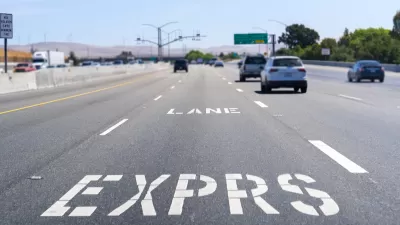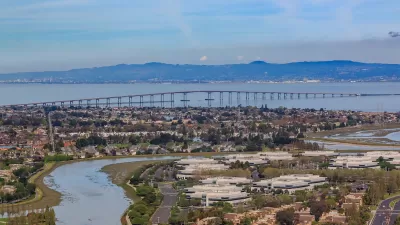The two-year-old I-405 express toll lanes are actually a trial. It's up to the legislature to decide whether they will be permanent. Two metrics were laid out: revenue and performance, but there's controversy there as well.
The Washington State Department of Transportation (WSDOT) has convincing data that the I-405 Express Toll Lanes are working as planned, writes Chris Sullivan, traffic reporter for KIRO Radio in Seattle.
WSDOT compared the performance of the five-lane I-405, composed of three general purpose and two express toll lanes (in one direction), with the five-lane I-5, composed of four general purpose and one carpool lanes.
“Same total number of lanes, same daily traffic volumes, and yet the peak hours on 405 are performing at a much higher level than the peak hours on I-5 where we are seeing a much higher level of congestion,” said I-405 project manager Kim Henry.
“That’s what express toll lanes do,” he said. “They keep the cars moving, and so we get a much higher performance on a lane-by-lane basis.”
Convincing or not, the express toll lanes have their opponents, as noted in the "tollway rebellion" sub-heading in a February 2016 post that indicated that speeds in the adjacent general purpose lanes had been decreasing.
As for the toll lanes themselves, Seattle Times transportation reporter Mike Lindblom wrote that same month that "[m]otorists are flocking to the I-405 express toll lanes, so much so that tolls [that spike to $9 or $10, the maximum, on occasion] in the opening months totaled $3.7 million, more than triple what the state had forecast."
It's a trial!
What was not noted in the first post on the opening of the lanes in September 2015 was that the lanes were constructed on a two-year trial basis.
The state legislature "launched tolling on the interstate as a two-year experiment and said it could become permanent if the lanes pay for themselves and cars move fast enough during the commute," report Jerry Cornfield and Melissa Slager for The Daily Herald of Everett, Wash. on Sept. 25, 2017.
We have some decisions to make and they will not be easy to make,” said state Sen. Curtis King, R-Yakima, chairman of the Senate Transportation Committee. “Are we going to bless it or are we going to discontinue it and if we discontinue it, what is going to replace it?”
Sen. Steve Hobbs, D-Lake Stevens, is the ranking Democrat on the transportation panel. He too said lawmakers need to see figures for two full years of tolling operations before passing judgment. [Hobbs is now chair].
Toll lanes need to meet two criteria
KIRO's Dori Monson explains the two criteria on Dec. 21, which ironically turns out to be controversial as well because they may not necessarily have to meet both benchmarks. In any case, it's impressive to see that these lanes are clearly paying for themselves.
According to a law set up by the Legislature, the I-405 express toll lanes were supposed to accomplish two main goals within 2 years of operation:
- The tolling system had to pay for itself. It has far exceeded that goal. Operational costs were $13.6 million over the 2 years. The lanes raised $38.6 million.
- The lanes had to flow at 45 mph, 90 percent of the time. They did not meet this goal, and only reached 45 mph a total of 82 percent of the time.
A representative of the state’s toll division told KIRO Radio: "The AGO [attorney general’s office] advised us that as the statute is written, the lanes must meet one of the two metrics to continue operating."
"We now know that the state Attorney General’s office doesn’t believe the I-405 express toll lanes need to be scrapped, despite not meeting both benchmarks set out by the Legislature," began Sullivan in his Dec. 22 report for KIRO. "But there is going to be a push in Olympia next month to get rid of them."
See the September 2015 post that distinguishes WSDOT's names for three types of managed lanes: express lanes, express toll lanes, and high occupancy toll (HOT) lanes. While potentially confusing, it's helpful to distinguish the Washington I-405 Express Toll Lanes from the California 405 Express Lanes.
Hat tip to David Schonbrunn.
FULL STORY: What would life be like without the I-405 toll lanes?

Study: Maui’s Plan to Convert Vacation Rentals to Long-Term Housing Could Cause Nearly $1 Billion Economic Loss
The plan would reduce visitor accommodation by 25,% resulting in 1,900 jobs lost.

North Texas Transit Leaders Tout Benefits of TOD for Growing Region
At a summit focused on transit-oriented development, policymakers discussed how North Texas’ expanded light rail system can serve as a tool for economic growth.

Why Should We Subsidize Public Transportation?
Many public transit agencies face financial stress due to rising costs, declining fare revenue, and declining subsidies. Transit advocates must provide a strong business case for increasing public transit funding.

How to Make US Trains Faster
Changes to boarding platforms and a switch to electric trains could improve U.S. passenger rail service without the added cost of high-speed rail.

Columbia’s Revitalized ‘Loop’ Is a Hub for Local Entrepreneurs
A focus on small businesses is helping a commercial corridor in Columbia, Missouri thrive.

Invasive Insect Threatens Minnesota’s Ash Forests
The Emerald Ash Borer is a rapidly spreading invasive pest threatening Minnesota’s ash trees, and homeowners are encouraged to plant diverse replacement species, avoid moving ash firewood, and monitor for signs of infestation.
Urban Design for Planners 1: Software Tools
This six-course series explores essential urban design concepts using open source software and equips planners with the tools they need to participate fully in the urban design process.
Planning for Universal Design
Learn the tools for implementing Universal Design in planning regulations.
Ascent Environmental
Borough of Carlisle
Institute for Housing and Urban Development Studies (IHS)
City of Grandview
Harvard GSD Executive Education
Toledo-Lucas County Plan Commissions
Salt Lake City
NYU Wagner Graduate School of Public Service




























